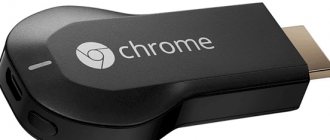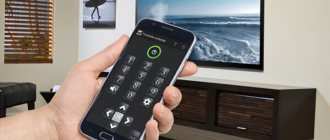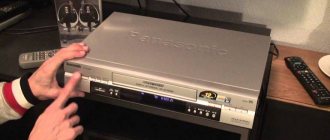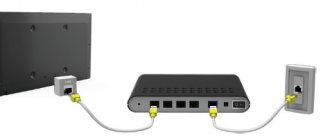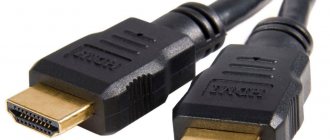How to find out if there is WI-FI on TV?
First, you should find out whether your TV model supports wireless connection technology.
How can I do that:
- First, study the documentation for the TV: there, the technical specifications always indicate the possibility of connection.
- If there are no documents, enter the name of your TV into any search engine and go to the manufacturer’s official website. Study the characteristics of the device, if the Wi-fi column says “Yes” or is +, then your device can connect to the Internet through a router.
Reference! If there is no information about connecting to the network, then Wi-fi technology can only be used after purchasing a special adapter.
In most Smart TVs, the Wi-fi module is built inside, which greatly simplifies the connection and setup process.
Choosing a router
Many users think that to connect a TV to Wi-fi they need some kind of special router. In fact, this is not true: your TV is the same device as, for example, a phone or tablet. If you already have Wi-Fi at home, feel free to buy a Smart TV and connect to the network.
However, it is not recommended to buy cheap routers : their bandwidth is lower, and connecting several devices at the same time is often impossible.
Suppose you connect several phones, a laptop, a TV at once - and the router stops distributing the Internet due to overload. In addition, within your Internet tariff, the speed may be greater than what the router is capable of delivering, and it turns out that you are paying for services that the router cannot provide.
Install the router in close proximity to the TV , and if this is not possible, buy a network cable in advance.
The last recommendation: always try to buy original devices, not Chinese counterfeits. If you are purchasing a router specifically for your TV, get the same model as your TV.
Why connect your TV via Wi-Fi
Wi-Fi is supported on a wide variety of devices. Over the past 10 years, the corresponding sensor has even begun to be installed in TV receivers. And here some people may involuntarily ask the question: why do you need Wi-Fi on a TV?
In fact, any person who actively uses modern technologies can answer the question asked. As we know, the Internet allows people to consume a wide variety of content:
- watch films;
- use YouTube;
- listen to music;
- view photos;
- play games.
Due to a person’s attachment to the global network, performing the indicated operations would be impossible without an Internet connection. Unfortunately, watching movies on a computer or smartphone screen and taking advantage of all the benefits of YouTube video hosting is not very convenient. The display diagonal does not allow for family viewing or even full enjoyment of the content on your own.
It’s another matter if you organize a home movie show on TV. TV screens are much larger than those on smartphones and computers. This means that TV has been and remains an ideal means for watching movies and TV series online. And here you can’t do without connecting to Wi-Fi. So this function is absolutely necessary for every person who loves to enjoy all the benefits of civilization.
Among other things, on a TV with Wi-Fi you can play online games, as well as use the Internet, just like on a computer. That is, look for the necessary information in the browser.
Connection options
There are several ways to connect your TV to Wi-fi:
- Using a wired connection.
- Via Wi-Fi.
- Via laptop.
Let's look at each of them in detail.
Using WI-FI wirelessly
This is the easiest and most convenient way to connect your TV to the Internet: you will need a working router, Smart TV or regular TV and a special WI-fi module, which can be purchased separately in the store.
Instructions:
- We go to the TV settings through the remote control by pressing the Menu button.
- Select the "Network" section.
- Go to "Network Settings".
- Click on "Wireless Connection Type".
- Select your network from the drop-down list and enter a password if you have one.
- Save your changes and exit Settings.
That's it, now you can use the Internet via Wi-Fi on your TV, watching videos or movies online.
Reference! If your TV does not have a built-in Wi-Fi module, you can purchase it separately. Visually, the device resembles a flash drive and is connected via a USB port.
Wired connection
To implement this method, you will need a TV with an Ethernet port, a router with a Lan port, and a UTP cable. You can purchase a regular Cat 5 patch cord.
After all the wires have been purchased and the router is turned on, we proceed to the setup:
- Insert one end of the patch cord into the Lan port on the router, the other into the corresponding connector on the TV until it clicks. If the connection is successful, the green LED on the cable will light up.
- If you haven't already done so, set up your router to connect to the Internet. To do this, use the instructions provided by the router manufacturer.
- Next you need to configure the TV. Go to menu - Network - Network settings. There we select the connection method: wired connection or via Lan cable, depending on the TV model.
- The automatic setup process will begin. Since the connection is wired, you do not need to enter a password. After the connection is established, close the settings menu and check the Internet for functionality.
This method has several disadvantages:
- firstly, the wires have to be pulled throughout the apartment, and this is not very convenient;
- secondly, not every TV model has an Ethernet connector;
- and thirdly, on some router models, when connecting directly, Internet distribution is suspended.
Using a laptop
You can also use a laptop as a router that distributes Wi-Fi. This option is available in modern devices, although it is inconvenient: it is better to buy an inexpensive router and distribute the Internet to all devices at once. If this is not possible, use a laptop. We'll figure out how to make everything work below.
There are several ways to distribute the Internet from a laptop:
- Via the command line.
- Through third party programs.
- Using the Mobile Hotspot function.
If you want to distribute the Internet from a personal computer, you will need to purchase an external or internal Wi-Fi adapter that connects over the network. Laptops have such an adapter built inside.
Regardless of the type of device, before setting up wireless Internet distribution, do not forget to connect your laptop to the network (via a cable, modem or mobile USB router), and also install the necessary drivers for Wi-fi.
Via command line
This method is suitable for Windows 7, 8 and 10.
- Run the command prompt as administrator (you can find it through the Start menu, in the search).
- We execute (enter it and press Enter) the command, where in the ssid= line we write the name of the network, and in the key line - the password for the network. This command will set the name and password for the network: Netsh wlan set hostednetwork mode=allow ssid=My_virtual_WiFi key=1234 keyUsage=persistent.
- To activate the access point, run the command. As a result, you should see “The hosted network has started”: netsh wlan start hostednetwork.
- Last step: share your network. Go to network connections, select the network through which you are connected to the Internet, right-click on it and go to properties. On the access tab, check the box “Allow other network users to use this computer’s Internet connection,” and below select the network whose name you specified in the command above.
- Now turn off the network with the command: netsh wlan stop hostednetwork.
- And turn it back on: netsh wlan start hostednetwork.
As you can see, distributing the Internet from a laptop without a router is possible, and setup will not take much time. However, after each reboot of the laptop, the distribution will have to be configured again .
If devices cannot connect to the created network, or connect to it but there is no Internet access, disable the antivirus and firewall.
Through third party programs
Distributing the Internet through special utilities is somewhat more complicated, it all depends on the program itself. If you decide to use this method, use utilities such as:
- Switch Virtual Router;
- Virtual Router Plus;
- Maryfi.
You need to install network drivers and follow the instructions for each program separately.
Mobile Hotspot feature (Windows 10 only)
This function is built into Windows 10 and is analogous to the above setup via the command line:
- Go to Settings, from there to the Network and Internet section.
- Select the function you are interested in in the menu on the left. Its settings will open on the screen - if desired, change the network name and password, save the changes.
- Switch the switch at the top to the on position, below select the network that you will use on multiple devices.
- That's it, if you have any problems, turn off Windows Defender and Firewall.
Regardless of the chosen method of distributing the Internet through a laptop, connect to the Internet from the TV following the instructions above. In the list of available networks, select the one whose name you specified during the setup process.
other methods
There are several more little-known ways to make your TV accept WIFI. They are not suitable for all models; it is recommended to check the availability of such functions before purchasing. Let's look at different ways to make your TV accept WIFI.
- WPS;
- One Foot Connection;
- Plug and Access;
- Mobile hotspot.
- To connect using WPS , go to the TV settings and find the corresponding function there, while simultaneously holding down the WPS button on the router for 15-20 seconds. The TV connection and setup will happen automatically.
- For One Foot Connection you will need a Samsung TV and the same router. To connect to the network, find this function in the TV settings and turn it on. That's it, you don't need to do anything else.
- To connect using the Plug and Access function , you will need a formatted flash drive. We insert it into the router, if the indicator lights up, then everything is correct. We remove the drive and connect it to the TV. The connection will be configured automatically.
- To distribute the Internet from your phone , use a mobile hotspot.
Go to settings - mobile networks - access point. Turn it on, set the network name and password and save the changes. Now connect from the TV to your network. When distributing the Internet from your phone, monitor the traffic: perhaps its uncontrolled consumption and debiting of funds from the account.
Connection via Smart TV Box
The Smart TV Box allows you to stream content from other devices, but it is also a standalone media player. Depending on the model, it provides access to various websites and applications without using a laptop or smartphone.
Smart TV Box is controlled using a remote control and sometimes by voice commands. Typically has larger flash memory than Wi-Fi adapters and sometimes allows you to connect external drives.
Typically, the HDMI TV connector is used to connect the device.
Is it possible to set it up if there is no Smart TV function?
Yes, you can. To do this, you will need a Smart set-top box on Android OS; you can buy it at any hardware store. A portable Wi-Fi module is also suitable.
The option with a set-top box is more interesting, as it allows you to watch videos, websites, download applications and talk on Skype. It connects via USB or HDMI port. Before purchasing, check whether your model can work with the set-top box - it is recommended to call support for this. After purchasing the set-top box, connect to Wi-fi using the instructions above.
External Wi-Fi modules are connected via USB ; you only need to buy them of the same model as your TV, otherwise there may be compatibility problems.
How to turn on Telefunken and configure channels?
Telefunken TVs operate on the Android system, so the connection on them is slightly different:
- Go to the device settings.
- In the “Network connections” column, select Wi-fi or Ethernet, that is, a wireless connection or cable.
- To connect via Wi-Fi, go to this section, the TV will load all found networks. We connect to ours, enter the password. That's it, the setup is complete.
- To connect via a cable, we run a wire, plugging one end into the router and the other into the TV. In the Ethernet column, select your network and connect to it.
On these models, it is also possible to connect using a phone or laptop hotspot. For additional features such as WPS or Plug and Access, please refer to the documentation for the device.
Now you know many ways to connect Wi-Fi to your TV, even if you don’t have a Smart-TV or Wi-Fi module. Choose the method you like and watch movies or videos online directly from the TV screen.
Manual setting
All parameters can be configured manually. To do this, go to the “Preferences” menu, first select “Network setup”, then “Wireless setup” and “Manual setup”. Use the arrow to point to the value “Network name – OK”. Using the keyboard, enter the name of the network. Save the settings by pressing the blue button. Next, select the “Identification” parameter and one of 4 values: “WPA2-PSK”, “Common key”, “Open system”, “WPA-PSK”. Click on the “Encryption” button and select one of the values: “TKIP”, “None”, “AES”, “WEP”.
Note that the encryption is “WEP” and “Niskol.” will be available if Open System is selected. If you selected the “Common key” value, then “WEP” will be available. For “WPA2-PSK” and “WPA2-PSK” - only “AES” and “TKIP”. After you have decided on encryption, select “Security Key – OK”. The security key is entered using the keyboard. If “None” encryption was selected, the element will be inactive. Next, click “Done – Ok”.

